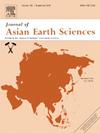Origin, maturity and geochemistry of natural gas in the Yancheng Sag, Subei Basin, China: Insights from pyrolysis experiments and basin modeling
IF 2.7
3区 地球科学
Q2 GEOSCIENCES, MULTIDISCIPLINARY
引用次数: 0
Abstract
Natural gas-sources correlation is crucial for determining the target of natural gas accumulation. The Zhujiadun gas field discovered in the Cretaceous Taizhou-Paleogene Funing (K2t-E1f) formations is one of the most important gas fields in the Subei Basin. However, the origin of natural gas in the Zhujiadun gas field is controversial, seriously restricting future exploration. In this study, organic geochemistry, gold-tube hydrous pyrolysis experiments, and basin modeling were performed to comprehensively investigate the origin, maturity and geochemistry of natural gas in the Zhujiadun gas field. The results show that: (1) the natural gas in this gas field is sapropelic-sourced thermogenic gas, which is predominately from the secondary cracking of crude oil. (2) New empirical equations for calculating the maturity of natural gas in the Yancheng sag are established based on the relationship between the carbon isotopic composition of methane and the thermal maturity of kerogen. The calculated average Ro value of natural gas is 2.2 %. (3) The Yancheng Sag has evolved through three subsidence cycles. Potential Paleozoic source rocks are currently in the post-maturity period, while the Paleogene source rocks are still in the oil generation window. (4) The natural gas in the Zhujiadun gas field predominantly originates from the source rocks of the Ordovician Wufeng-Silurian Gaojianbian formations. These results provide insights into the source of natural gas in the Zhujiadun gas field and a basis for natural gas exploration in the future.
求助全文
约1分钟内获得全文
求助全文
来源期刊

Journal of Asian Earth Sciences
地学-地球科学综合
CiteScore
5.90
自引率
10.00%
发文量
324
审稿时长
71 days
期刊介绍:
Journal of Asian Earth Sciences has an open access mirror journal Journal of Asian Earth Sciences: X, sharing the same aims and scope, editorial team, submission system and rigorous peer review.
The Journal of Asian Earth Sciences is an international interdisciplinary journal devoted to all aspects of research related to the solid Earth Sciences of Asia. The Journal publishes high quality, peer-reviewed scientific papers on the regional geology, tectonics, geochemistry and geophysics of Asia. It will be devoted primarily to research papers but short communications relating to new developments of broad interest, reviews and book reviews will also be included. Papers must have international appeal and should present work of more than local significance.
The scope includes deep processes of the Asian continent and its adjacent oceans; seismology and earthquakes; orogeny, magmatism, metamorphism and volcanism; growth, deformation and destruction of the Asian crust; crust-mantle interaction; evolution of life (early life, biostratigraphy, biogeography and mass-extinction); fluids, fluxes and reservoirs of mineral and energy resources; surface processes (weathering, erosion, transport and deposition of sediments) and resulting geomorphology; and the response of the Earth to global climate change as viewed within the Asian continent and surrounding oceans.
 求助内容:
求助内容: 应助结果提醒方式:
应助结果提醒方式:


